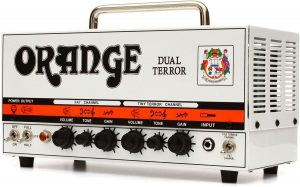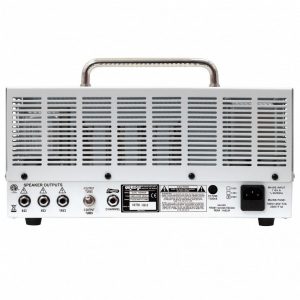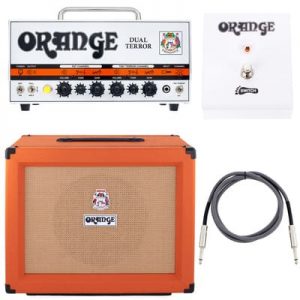If you loved the Tiny Terror but need more power or a boosted second channel, then the Orange Dual Terror could be your new squeeze. Review by Dave Walsh
When Orange unveiled the all-valve Tiny Terror in 2007, the performance of this DVD boxset-sized amp caused a sensation among tonehounds. Some, however, fancied a bit more flexibility. And if you were amongst them then your wishes have been granted in the form of the Dual Terror. An amp that promises more sounds while retaining those diminutive proportions.

Slipping open the padded nylon gigbag unveils one of the best-looking and most desirable amps that we’ve seen since. Well, since the Tiny Terror. Resplendent in a smooth white powder-coated finish. The aluminium chassis allows you to glimpse the quartet of EL84 valves that peek through the grille at the rear, while peering down into the top reveals four 12AX7 preamp valves.
Further echoes of the TT include the rigid chrome handle, the classic orange. Black and white colour scheme and the high-quality components, with switches and jack sockets that should be durable enough to withstand the sweatiest of stage environments.
New additions are the inclusion of the channel names across the face and, of course, increased dimensions to house the second preamp circuitry and extra valves. So while the Dual is a bit larger than the Tiny Terror. It’s not so much larger that it alters the amp’s status as an ultra-compact head, nor does it take away its spine-friendly portability.
Features Orange Dual Terror
Table of Contents
The two channels labelled ‘Tiny Terror’ and ‘Fat’ have identical three-knob layouts for Volume. Tone and Gain with Orange’s unique schematic symbols and music notation above the control designation (they include the written word too, for the harder of thinking among us).

This dashboard layout is not only home-made handsome but straightforward and intuitive. Just the way it should be on an amp designed for live use. There’s a single instrument input, a chrome on/off switch and a three-way switch for full/standby/half power. Plus a two-way switch to select channels (a footswitch is optional).
The back panel’s features include three speaker outputs. Twin 8 ohm inputs for two 16 ohm cabs or a 16 ohm input for a single cab – and a switch to choose between four or two output valves.
As with the Tiny Terror, there’s no effects loop. While the TT had 15W or 7W operation, the Dual includes an additional 30W operational power stage. This 30W mode promises enough headroom to kick out warmth and high end sparkle without unwanted signal break-up. With enough volume to push up to two extension cabs.
Orange PPC212 cab
Orange call this partially open-backed cab a PPC or Power Projection Cabinet. It’s made from high-density 13-ply 18mm-thick birch plywood, so it’s sturdy. The whole cab is covered in orange vinyl with a neatly bevelled inner edge to the grille cloth and two logos. A coat of arms and the company’s banner.

Behind the grille, two 12″ Celestion Vintage 30 speakers are rated at 120W output RMS at 16 ohms. Comfy flush cabinet handles complete the no-nonsense build while four ‘skid’ feet anchor the cab to the stage to provide a tight bass and full range definition.
Sounds
In use the Dual can be seen as two switchable Tiny Terror preamps, with added girth and gain in the Fat channel. In addition to 7W and 15W settings. The Dual Terror can put out 30W of Class A power. Hooking up the cab is as straightforward as it should be. And far from looking rather odd atop the hefty 2×12″ cab. The Dual Terror fits snugly and kinda glares out at you like the pint-sized tough kid at school.
A modified P90-equipped Tele with an ash body and maple fingerboard stoked the TT channel to life. And at small gig levels it sounded reassuringly like the original TT. The larger chassis size and extra power do change the fundamental tone to some degree. But the Dual Terror doesn’t lack the essential nuances that made the Tiny Terror so pleasing in every gain range.
The voice is open, warm and punchy, translating that great nowhere-to-hide P90 tone into a clanging voice on each output setting. Just tweak the tone control. And add a push from the gain control and you’ll get an eyebrow-raising rock crunch that would make Pete Townshend nod sagely in approval.
Flicking the chunky three-position switch down to engage the Fat channel introduces a subtle low-end lift. And with a touch more gain on tap at volume there’s a noticeable snub-nosed roundness to higher notes, plus a thicker presence in the bottom end. The extra power and more valves equate to more headroom and enough volume to make the 2×12″ shift some serious air. And anything else not nailed down in the immediate vicinity.
Verdict Orange Dual Terror
If the Tiny Terror astonished us, its larger brother nonchalantly tops it. It’s a more versatile amp, but Orange has managed not to affect the features that made the original so adored. If you loved the little one but crave more power. And the ability to switch between rhythm and lead settings in the studio or on stage. The Orange Dual Terror easily provides two of your five-a-day recommended allowance. The optional footswitch really should be included, but that small gripe aside. The Dual provides an extra notch of punch with a warm, balanced valve sound. Factor in the impressive headroom in 30W mode. And the Dual Terror is a very capable topping for 2×12″ or even 4×12″ speaker cabs for live settings. Anybody suffering from size issues really needs to visit a shrink before dismissing this one. Because it offers realistic portability brimming with maximum bang. And all at a price designed to make a good few boutique amp builders cringe. The Dual Terror could be the hand grenade in anyone’s amp arsenal.

Leave a Reply
You must be logged in to post a comment.